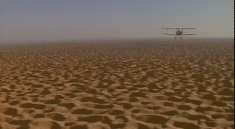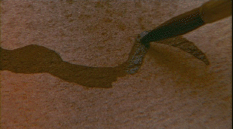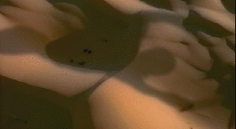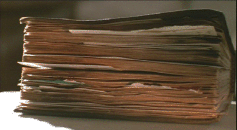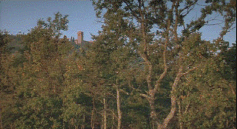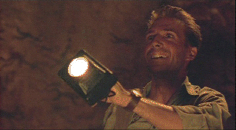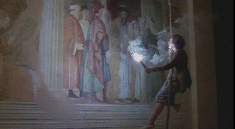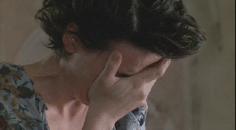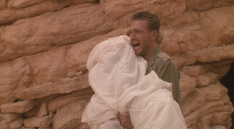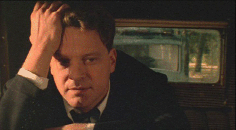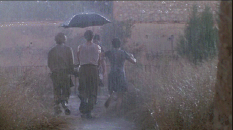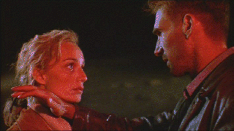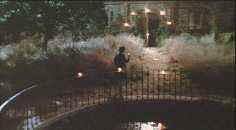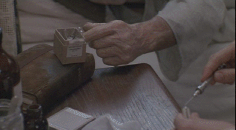directed by Anthony Minghella
review by Gary Tooze
Producers are not always considered important creative contributors to a film. Saul Zaentz is the premium exception. Working independently, he purchases strong literary works (`"One Flew Over the Cuckoo's Nest,'' "Amadeus,'' `"The Unbearable Lightness of Being,'' etc. ) and turns the film adaptation into his personal projects. Zaentz, and many critics, loved Minghella's first film, "Truly, Madly, Deeply," made in 1991. Zaentz decided that he wanted to work with him. Minghella brought "The English Patient" to him and thus was a brief renaissance of classical, emotionally charged, visually sumptuous cinema. Zaentz was courageous and obstinate and Miramax, a division of Disney, bailed out the production for the almighty dollar. Sticking to his guns with the casting there are no American "stars" (Willem Dafoe's, as Caravaggio, the exception) in The English Patient perhaps keeping that part of the budget in check. It was shot in North Africa and Italy made for the paltry sum ( By Hollywood standards ) of $31 million, proving a better investment than Microsoft, and garnering 11 Academy nominations taking 9 of them home with the massive bulk of its revenue arriving after that acclaim.
( IN ALL CASES - CLICK ON IMAGES FOR LARGER VERSIONS )
|
The English Patient is a non-linear story that has an elliptical structure, beginning and ending with the same scene whilst delicately meandering back and forth from the late 30's Africa, to 1945 Italy... just as the amnesiac title character recalls the events that his memory is gradually regaining. Minghella is able to smooth over what ought to have been extremely confusing gaps and jumps in chronology with splintered structures and individual narratives about characters that are often never linked together. In the end he has created an extremely coherent story which is set against an backdrop of complex political, archaeological and love triangle vistas. |
Like other drama films, The English Patient centers around the defining moments in one, or a few peoples, lives. War and the threat of war are most effective for these personal dramas which often coincide with the characters most impassioned love affairs. Michael Ondaatje's The English Patient had the premise already set with his winner of Britain's prestigious Booker prize, the novel of the same name. The English Patient as a literary work has become one of the most popular and widely read in the past decade. Minghella went about the impossible task of writing the screenplay, weaving through the labyrinthine of the novel.
|
Before even the first scene, The English Patient begins with a close-up of a painter's brush outlining a dancing figure on a rough surface. We have no idea who or where the painter is. We will be enlightened before the end of this fascinating film as the pieces of the puzzle start to come together. |
Questions like this are one of the things I enjoyed most about director and screen writer Anthony Minghella's magnificent cinematic contribution to the forgotten genre of expertly honed melodramas. His themes become so complex, deeply layered, and subtly defined that it sustains such longevity in re-watch-ability.
As Roger Ebert says:
|
“It’s the kind of movie you should see at least twice--first for the questions, the second time for the answers." |
|
Katherine's painting in the first scene ( actually as the first credits come up ) drifts onto the contours of the Tunisian desert and gracefully "swims" along the rippled sand dunes peaks and valleys. "Swims" as in the "Cave of Swimmers". There is no chance to make this parallel except on a second viewing. |
With the help of breathtakingly epic photography of much deserved Academy Award winner John Seale, Minghella folds the symphony of images and a mass of material into a 161-minute true masterpiece reminiscent of David Lean grandeur. His accomplishment seems Herculean. Minghella shows himself as a complex and meticulous artist whose work will last as long as the paintings in the "Cave of Swimmers". Not only can he be compared to Lean in the richness of his visual sense but also in his stalwart attention to details and fragments of memory that transplant strong feelings before we can hope to understand their significance in the story. His creative camera angles add a further depth to his film craft that pushes him to the forefront of influential directors of this era.
Quote from Richard Malloy:
|
"
Here's a director who's films are so intricately and carefully composed
that a re-edit is a practical impossibility (in this way, he's very much
like Hitchcock in that he constructs his puzzle ahead of time - there's
really only one way it can fit together). Each shot, each scene, each
tiny bit of information leads inexorably to the next, building upon what
came before, fleshing out themes and drawing together that which
previously seemed disparate and unrelated. Every tiny musical theme,
every object in the mise-en-scene, every cinematic gesture no matter how
subtle has meaning - and it's all of-a-piece.
|
|
Much of the central theme of the story is liturgical and derived from E.M. Forster's celebrated dictum that, if he were forced to choose between betraying his friends and betraying his country, the conflict of private feeling over public duty, he would hope to have the guts to betray his country. The novel, The English Patient can respectfully be an ode to Herodotus, the first western historian. The book that was found on the psychologically complex loner, Almasy's, badly burned body—an old leather-bound pocket-book of the "Herodotus' Histories ", with scraps, notes, poems and drawings that he has pasted or folded inside is a major clue to telling us his story. |
The film contrasts the pale sepias of the Tunisian desert with the lush greens of Northern Italy surrounding the abandoned Tuscan monastery where the story shares how war has had it's effect on five of it's characters.
Hana
( Juliette Binoche ) is a French-Canadian nurse who must stay with Count Laszlo
de Almasy (Ralph Fiennes), who, in Egypt before the war, was attached to the
Royal Geographic Society, and is now horribly
burnt and disfigured and referred to as "The English Patient". She
acts
not only as his foil and to counter balance his stories, but as a conduit for
him to express to, as we, the audience can also then hear his story. The war has
damaged her heart and she is subtly healed by his revealing story. Her own
experiences with love and death, which at first seem devastating in relative
terms, pale in comparison to Almasy's with the confident and witty Katherine
(played by Kristin Scott Thomas). Caravaggio ( Willem Dafoe )is
also instrumental in helping Almasy, who has no recollection of previous events,
rediscover some of the more agonizing details of his past.
Perhaps deeply intellectual, juxtaposition with a variety of interesting parallels, especially between Count Almasy and Hana are another strong theme in the story. Both have felt the sting of death after love because of war-time activity. Both feel cursed and reticent to express that emotion again. The monastery is not only for his removal of pain, but for her as well. As he opens up to her and us, Hana's own physiological pain disappears. Her wounded heart is mending. He becomes her father-figure ( she can be seen playing Hopscotch by herself, and mentions to Bomb disposal expert Hardy, played by Kevin Whately, how she "feels as clumsy as a child" ), and Ondaatje's book informs us that Hana's own father was burned to death fighting in France. Her daughter-like kisses on his leather textured head complete the bond.
Almasy's look of utter joy as he beholds the hidden art treasures of the "Cave of Swimmers" is repeated in Hana's expression as Kip hoists her to the top of the cavernous cathedral ceiling to explore the magnificent paintings found there.
There are only two episodes in the film that characters show their sorrow by openly weeping. Hana must fight to overcome her emotions and regain her professionalism as she administers the lethal overdose that will end Count Almasy's life. Almasy is allowed to reminisce his great love affair ( as the audience finally sees Katherine's outcome ) with it's tragic ending. Hana reads to him ( and us ) and he drifts to an endless sleep.
"Cheek to Cheek".
Played on the radio as tormented Geoffrey Clifton witnesses his wife's infidelity from the back of a taxi, it is also the song played as Almasy is carried out in the rain as the end of the war is celebrated by the five characters.
The horribly burnt and disfigured face of the " English" patient compares to the handsome profile of the Count played to perfection by Ralph Fiennes who has the looks of a 1940's matinee idol. He has the magnetism of a young Bogart as his character displays much of the strong silent attributes that Bogie did in such films as Casablanca. Fiennes, like Bogart, is also a magnificent and versatile actor. Almasy is a quiet, brooding, self-centered man, but Fiennes is able to give him a sympatric angle by eventually showing us his weaknesses. This is especially true as he convalesces in the monastery. He subtly becomes a matchmaker for the wholesome romance between the Sikh named Kip ( played by Naveen Andrews ), a bomb disposal expert, and Hana. It provides a balance to the moral ambiguity around his own . A love with as strong a passion as can only found in adultery. Minghella is able to convey this without ever becoming vulgar.
|
Minghella is so detailed that his lighting fluctuates as the bright red flairs burn into the night sky as strong moment of truth can be read in Katherine's eyes as she returns his loving gaze. Their restraints are are shortly to become overthrown. |
|
Countering the passion of Katherine and Almasy is the wholesome love affair of Hana and Kip. In the scene above he reaches out to her in with yet further Minghella beautiful imagery, leaving her a trail of snail shells with a small burning flame inside, leading her to him. |
|
Subtly Almasy's noble character requests his euthanasia from Hana by tipping over the box of morphine. |
It makes a terrific DVD ( No extras from Miramax ) and even better Laserdisc that Criterion went to the mat with it's additions. The DVD is presented on one side in dual-layer format and has been letterboxed with an aspect ratio of about 1.82:1 and no 16:9 enhancement. The color transfer is excellent, and the film’s many challenging lighting effects are presented without flaw. The stereo surround sound is superb, with a deep dimensional atmosphere powerfully impacting at appropriate moments. The Dolby Digital track is even richer, with a more detailed mix and slightly stronger surround separations. the Laserdisc, unlike the DVD is filled with extra's and deleted scenes with commentary by Minghella himself.
Is The English Patient melodramatic? Of course, but it' is so subtle and finely detailed that it simply warms its viewers as opposed to smothering them. Many of the scenes reflecting on the past without purpose can be quite lengthy, and for the uninitiated viewer are seen as unwanted interruptions. Today's cheap-thrill following has viewed this as boring. How unfortunate. There is no casual, filler dialogue. It is all rich with mystery and love, often following multiple storylines is difficult for many viewers and the characterizations perhaps far too subtle for most of today's modern audiences. This is a film for lovers of classic literature and sweeping epic love stories flowing ( but not overflowing ) with romance. It is not often made today. For what it attempted, it achieved perfection.
Regardless of enjoying the style of story or the story itself, from an analytical standpoint of superior production values it is a work of brilliance. It's well worth watching, several times even, for this is a rich, compelling motion picture, and you'll learn more from each viewing. The characters seem to blossom forth with each viewing as you cannot help but embrace them.
There is no reason to give it anything except
![]() out
of
out
of ![]()
Full Cast and Crew for
English Patient, The (1996)
Directed by
Anthony Minghella
Writing credits (WGA) (in credits order)
Michael Ondaatje (novel)
Anthony Minghella (screenplay)
Cast (in credits order) verified as complete
Ralph Fiennes .... Almásy
Juliette Binoche .... Hana
Willem Dafoe .... Caravaggio
Kristin Scott Thomas .... Katharine Clifton
Naveen Andrews .... Kip
Colin Firth .... Geoffrey Clifton
Julian Wadham .... Madox
Jürgen Prochnow .... Major Muller
Kevin Whately .... Hardy
Clive Merrison .... Fenelon-Barnes
Nino Castelnuovo .... D'Agostino
Hichem Rostom .... Fouad
Peter Rühring .... Bermann
Geordie Johnson .... Oliver
Torri Higginson .... Mary
Liisa Repo-Martell .... Jan
Raymond Coulthard .... Rupert Douglas
Philip Whitchurch .... Corporal Dade
Lee Ross (I) .... Spalding
Anthony Smee .... Beach Interrogation Officer
Matthew Ferguson (I) .... Injured Canadian Soldier
Jason Done .... Kiss Me Soldier
Roger Morlidge .... Sergeant, Desert Train
Simon Sherlock .... Private, Desert Train
Sebastian Schipper .... Interrogation Room Soldier
Fritz Eggert .... Interrogation Room Soldier
Sonia Mankaï .... Arab Nurse
Rim Turkhi .... Aicha
Sebastian Rudolph .... Officer in Square
Thoraya Sehill .... Interpreter in Square
Sondess Belhassen .... Woman with Baby in Square
Dominic Mafham .... Officer, El Taj
Gregor Truter .... Corpora, El Taj
Salah Miled .... Bedouin Doctor
Abdellatif Hamrouni .... Ancient Arab
Samy Azaiez .... Kamal
Habib Chetoui .... Al Auf
Philippa Day .... Officer's Wife (as Phillippa Day)
Amanda Walker (I) .... Lady Hampton
Paul Kant .... Sir Ronnie Hampton
Produced by
Steve E. Andrews (associate)
Scott Greenstein (executive)
Bob Weinstein (executive)
Harvey Weinstein (executive)
Saul Zaentz
Alessandro von Norman (line)
Original music by
Gabriel Yared
Non-original music by
Johann Sebastian Bach (from "Goldberg Variations")
Cinematography by
John Seale
Film Editing by
Pat Jackson (II) (associate)
Walter Murch
Casting
Michelle Guish
David Rubin (III)
Production Design by
Stuart Craig
Art Direction
Aurelio Crugnola
Set Decoration
Aurelio Crugnola
Stephanie McMillan
Costume Design by
Ann Roth (I)
Makeup Department
Giusy Bovino .... hair stylist
Fabrizio Sforza .... makeup artist
Production Management
Franco Ballati .... unit production manager
Lynn Kamern .... unit production manager
Second Unit Director or Assistant Director
Steve E. Andrews .... first assistant director (as Steve Andrews)
Gianni Arduini .... first assistant director: second unit
Andrea Girolami .... assistant director
Moez Kamoun .... first assistant director: Tunisia
Peter Markham .... second unit director
Enrico Marrari .... second assistant director
Emma Schofield .... second assistant director
Luigi Vallini .... assistant director
Art Department
Taieb Jallouli .... art director: Tunisia
Sound Department
Michael Axinn .... apprentice sound editor
Mark Berger (I) .... sound re-recording mixer
Malcolm Fife .... foley editor
Pat Jackson (II) .... sound supervisor
Stephen Kearney (II) .... assistant sound editor
Mark Levinson (II) .... adr supervisor
Marnie Moore .... foley artist
Walter Murch .... sound
Jennifer Myers .... foley artist
Christopher Newman (I) .... production sound mixer
John Nutt .... sound editor
Margie O'Malley .... foley artist
David Parker (III) .... sound re-recording mixer
Robert Randles .... music editor
Ivan Sharrock .... sound
Diego Taborda .... sound intern
Jennifer L. Ware .... sound effects editor
Visual Effects
Richard Bain .... digital effects compositor
Frazer Churchill .... digital effects compositor
Dan Glass .... visual effects compositor
Dennis Lowe .... visual effects supervisor
Kevin Phelan .... scanning and recoding producer: CFC London (uncredited)
Stunts
Jim Dowdall .... stunt supervisor
Franco Maria Salamon .... stunt co-ordinator (as Franco Salamon)
Other crew
Remi Adefarasin .... director of photography: second unit
Amel Becharnia .... production coordinator
Andrea Borella .... transportation manager
Phil Bray (I) .... still photographer
Fabiomassimo Dell'Orco .... location manager
Dianne Dreyer .... script supervisor
Daniel Farrell .... first assistant editor
Morris Flam .... gaffer
Paul J. Franklin .... computer animator
Giorgio Gallani .... location manager
Judith Goodman .... production coordinator
Robert Grahamjones .... assistant editor
Hannah Green .... researcher
Ling Ling Li .... music coordinator
Julian Mann .... computer animator
Harry Rabinowitz .... conductor
Robert Randles .... soundtrack producer: Golden Reel
Keith Roberts (II) .... computer animator
Deborah Ross .... title designer
Enzo Sisti .... production auditor
Jeffery Stephens .... assistant picture editor
Aminta Townshend .... set production assistant
Technical
Information
Release Information:
Studio: Miramax Home Entertainment
Reason for Rating: For sexuality, some violence and language.
Theatrical Release Date: November 15, 1996
DVD Release Date: March 24, 1998
Run Time: 162 minutes
Production Company: Miramax
Package Type: Keep Case
Aspect Ratio(s):
Widescreen Letterboxed - 1.82:1
Discographic
Information:
DVD Encoding: Region 1
Layers: Dual
Available Audio Tracks: English (Dolby Digital 5.1)
Available subtitles: Spanish
Edition
Details:
• Region 1 encoding (US and Canada only)
• Color, Widescreen, Closed-captioned, HiFi Sound, Surround Sound
• Widescreen letterbox format
• ASIN: 6304806426
